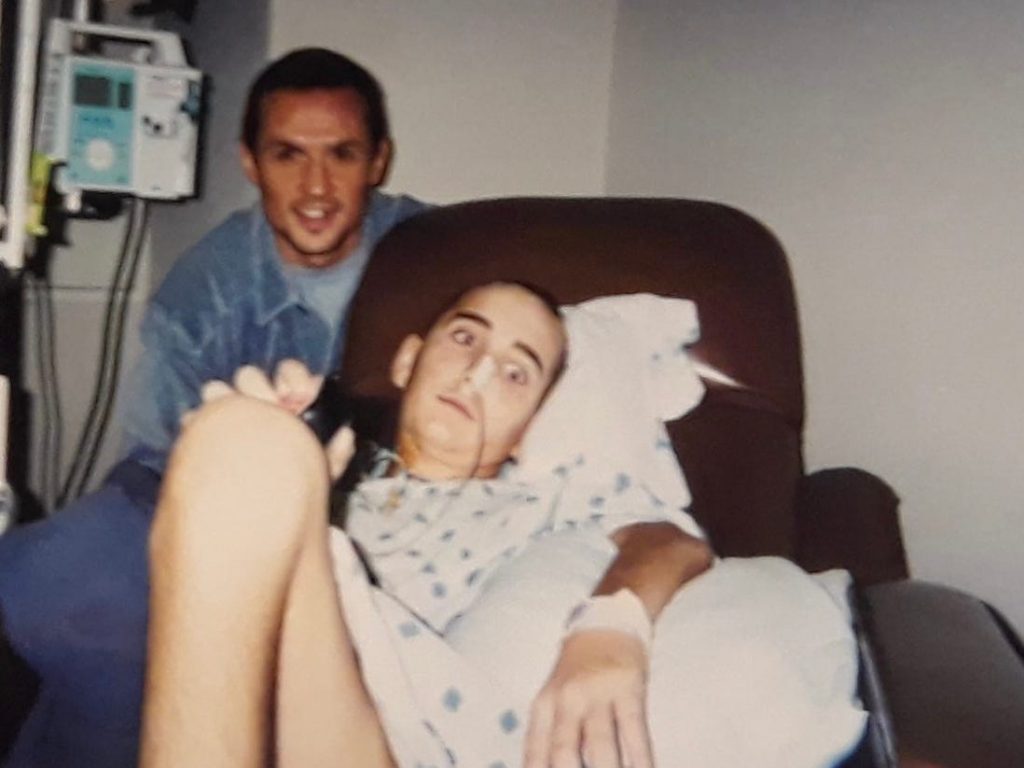- Trevor Turner was 14 when he experienced a headache and tingling on his left side.
- He'd experienced a severe brain bleed, and about a year later, had a life-threatening complication.
- Now 36, Turner is raising awareness about the importance of brain injury survivors' mental health.
Trevor Turner was eating dinner with his family at age 14 when a headache hit that would change the course of his life.
At first Turner, then a typical high-school freshman in Michigan, didn't think anything of the headache. He just asked his parents for a painkiller to dull it. But then, the left side of his body felt tingly. "That's kind of weird," he said he thought.
His parents took him to the doctor, who asked Turner to touch his left finger to his nose with his eyes closed. He failed. "I was looking at my mom like, 'Hey mom, look how crazy this is!'" but not with any fear or urgency, he said.
Those emotions fell on the doctor, who called an ambulance. Turner threw up in the vehicle, passed out, and doesn't remember much else of the next six-plus months. He'd experienced a serious brain bleed from a ruptured arteriovenous malformation (AVM), a rare condition he hadn't known he was born with that tangles the brain's blood vessels.
Only about 10% of strokes — which describe any disruption of blood flow in the brain — occur in people younger than 50, and the risk goes down the younger you are, Dr. Donald M. Lloyd-Jones, president of the American Heart Association, previously told Insider.
AVM is rare, and doesn't always lead to a brain bleed. But when it does, it's often among children and young adults, according to the Mayo Clinic.
Now 36 and with most of his functioning, Turner talked to Insider about life after a brain injury, and why mental health treatment is just as, if not moreso, important than physical rehabilitation. "When you come out of a brain injury," he said, "you're a new person."
Turner had another stroke a year later
That first night in the hospital, doctors told his family to call in clergy because they weren't sure he'd make it. But he did, and eventually clinicians were able to insert shunts in his brain to drain the fluid and help with swelling.

Turner remained in a medically-induced coma for four weeks, and couldn't speak for four months. He underwent physical, occupational, and speech therapy. By the time the next school year began, Turner returned to start his freshman year again.
But one day during class, his left side felt more tingly than usual. An MRI found such severe swelling around his original bleed, the doctor said it was inoperable. Turner's original surgeon, who the family then went to see in Ohio, said the same thing.
So the family drove to Buffalo, New York, for an experimental laser surgery. It was unsuccessful. "I was ready to die and death didn't sound all that bad considering I could barely walk, talk or eat," Turner wrote on his website.
Back in Michigan, Turner and his parents met with neurosurgeon Dr. Gregory Thompson, the same doctor who treated Kelly Stafford's noncancerous brain tumor. Thompson agreed to take the case, and the surgery was successful.
"I remember getting out of the surgery and Dr. Thompson saying, 'Go on and live a normal life,'" Turner said.
Fatigue and mental health are top concerns among brain injury survivors
For the most part, Turner has done just that — he completed high school in college, and went on to hold multiple jobs in journalism and marketing. He got into music and poetry, and moved to Denver for a few years.
But Turner, who now works in account management, continues to live with some invisible effects of brain damage, like fatigue, double-vision, and a lack of some sensation on his left side. He's learned he needs to prioritize his mental health too by meditating daily, eating well and exercising, practicing gratitude, and occasionally checking in with a neuropsychologist.
Before he had those supports in place, Turner was riddled with anxious thoughts. He avoided shrimp pasta, the dish his family ate the night of that fateful headache. Once on the way to physical therapy, he remembers thinking, "If we don't pass this car, I'm gonna have another brain injury."
"Even still to this day," Turner added, "my left side might get a little tingly, and I always think, 'Is it happening again?'"
Turner started a website called Brain Talk and a podcast called "The Bleeding Brain" to raise awareness about brain injuries and to support other survivors. In polls he's conducted, Turner's found fatigue, anxiety and depression, and memory loss are the top concerns. He's developing a course to help address them.
"Many brain injury survivors call it the silent disease because even though many look normal from the outside, there can be a lot of discomfort with the paralysis, double vision, and aches," he said. "So if you know a brain injury survivor, ask them how they are doing and gain an understanding of what they go through."

